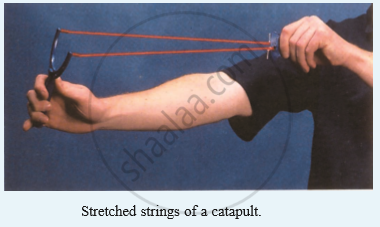Advertisements
Advertisements
प्रश्न
Two bodies having equal masses are moving with uniform speeds of v and 2v respectively. Find the ratio of their kinetic energies.
उत्तर
Let the masses of the two bodies be (m1) = m kg and (m2) = m kg .
Velocity of the first body, (v1) = v m/s
Velocity of the first body, (v2) = 2v m/s
The required ratio is-
= `"(Kinetic energy)"_1/"(Kinetic energy)"_2`
= `(1/2 (m_1)(v_1)^2)/(1/2 (m_2)(v_2)^2)`
So put the values to get ,
= `(1)^2/(2)^2`
= `1/4`
The ratio of K.E is, K.E of body 1 : K.E of body 2 = 1 : 4.
APPEARS IN
संबंधित प्रश्न
What type of energy is possessed : by the stretched rubber strings of a catapult?
A ball of mass 0.5 kg slows down from a speed of 5 m/s so that of 3 m/s. Calculate the change in kinetic energy of the ball. State your answer giving proper units.
An iron sphere of mass 10 kg has the same diameter as an aluminium sphere of mass 3.5 kg. Both the spheres are dropped simultaneously from a tower. When they are 10 m above the ground, they have the same :
Name the device or machine which convert :
Light energy into electrical energy.
What kind of energy transformations take place at a coal-based thermal power station?
The hanging bob of a simple pendulum is displaced to one extreme position B and then released. It swings towards centre position A and then to the other extreme position C. In which position does the bob have :
(i) maximum potential energy?
(ii) maximum kinetic energy?
Explain the transformation of energy in the following cases :
(i) A ball thrown upwards.
(ii) A stone dropped from the roof of a building.
Name the energy transfers which occur when : a torch is on
An object is falling freely from a height x. After it has fallen a height `pi/2` , it will possess :
A body of mass 10 kg falls from a height of 20 m to 8 m. Calculate:
- the loss in potential energy of the body, and
- the total energy possessed by the body at any instant? (Take g = 10 m s-2)
